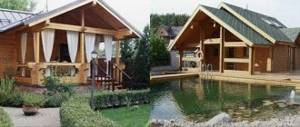26.08.2012
The most radical type of hardening in a bathhouse is swimming in an ice hole. For many, the mere mention of this phrase causes a shudder and a natural fear of icy water, although in Rus', from ancient times, diving into an ice hole after a steam room is not such an unusual thing. Therefore, the purpose of this article is to convey information about diving into an ice hole, as well as the harm that thoughtless and unprepared swimming in winter can cause.
What happens to the human body when swimming in an ice hole
The effect of cold water on the human body begins with the fact that blood vessels narrow under the influence of cold, reducing blood flow to the skin and peripheral organs. Blood flow to the internal organs, on the contrary, increases, supplying them with additional portions of oxygen and nutrients. Thus, heat is retained inside the human body.
After swimming in ice water, the effects of cold stop, the body begins to warm up, and the blood vessels dilate. A person experiences a pleasant feeling of warmth coming to the skin. His physical activity increases, vigor and joy from what he has done appear. We can say that this is similar to gymnastics of the cardiovascular system as a whole, thanks to which the efficiency of metabolic processes in the body increases.
Ice water also increases the activity of the respiratory system - it becomes deeper and easier. A strong nervous system, thermoregulation and protective functions of the body of a person who regularly engages in winter swimming have a beneficial effect on his health. Such common diseases as colds and viral diseases occur much less frequently in him than in a non-hardened person.
It must be borne in mind that staying in cold water for too long leads to a large loss of heat in the body. Constricted blood vessels are unable to compensate for this loss, and as a result, hypothermia with all the negative consequences. Dosed and correct stay in the ice hole should be the main criterion for any person.
Who needs a knee-deep ice hole in Moscow?
In physics, the term “hardening” means giving a substance greater hardness properties. But in truth, you need to have enormous strength of spirit and character to plunge into icy water in winter. Which, by the way, is also called hardening, only in the medical field. The end of autumn and the beginning of winter is the traditional time when the ice freezes on the reservoirs and the summer swimmers are replaced by real thrill-seekers - “walruses”. RD found out how to prepare the body for winter swimming, whether it is worth dipping a child into an ice hole and what ailments hardening can save from.
Temper yourself like steel!
Of course, hardening is very beneficial for the human body. The latest two-year studies by Russian doctors have proven that the number of colds in walruses is five times lower than in ordinary people - and the period of illness itself is also much shorter. However, the effectiveness of hardening becomes obvious only when hardening procedures are carried out over many years. In this case, it is important to observe a consistent decrease in water (air) temperature and gradually increase the procedure time.
You can start with the simplest thing - exercise in front of an open window, and then move on to walks in the fresh air and sports activities. The main thing is to develop consistency in your training and not take more than two or three days off. Because long breaks in hardening reduce the body’s developed resistance to low temperatures.
Winter swimming is essentially the apogee of hardening. But under no circumstances should you throw yourself into an ice hole without special training! Many people prepare for winter swimming for years. Viktor Yushchenko , a Moscow “walrus” with three years of experience and the author of the popular website “Soviet Walrus”, shares the secrets of winter swimming with RD: “If you are training for the first year, then before swimming you need to do an energetic warm-up; For people who have been swimming for more than a year, warming up is not necessary. Quickly get into the water, dive up to your neck and swim breaststroke, working hard. After finishing swimming, immediately run to the locker room (if there is one near the ice hole), or stand on the mat and quickly dry yourself with a towel. Then rub yourself with your palms and quickly get dressed.
In the first year, the duration of swimming (in the ice hole) should not exceed 25 seconds (the very first dive is only for 1-3 seconds), in the 2-3rd year this procedure can last up to a minute, and only with experience of 3-5 or more years - bathing for up to 1.5-2 minutes.”
By the way, walruses usually don’t dive headlong. The fact is that the head is extremely sensitive to cooling, so it will be difficult to hold out in the ice hole for the allotted time. In addition, walking home in the cold with a wet head may not be pleasant or useful for everyone. Viktor Ivanovich began winter swimming at the age of 46 and now he very much regrets that he did not harden himself in childhood, since he tested for himself that walruses avoid colds and illnesses.
Children in an ice hole - life-threatening?
Is it worth hardening children? And at what age should you start? From the first year of life, teach your child to walk in the fresh air, preferably at least 4 hours a day. First, this is sleeping in a stroller on the balcony or on the street, then walking, preferably not in a stroller, but with active movements. It has been proven that in nurseries, where children walk for 3-4 hours every day, respiratory morbidity is reduced by 3-4 times.
In general, we should strive to ensure that hardening evokes only positive emotions. You should not forcefully pour ice water on your child; you need to harden your child without fanaticism! As for winter swimming, before jumping into the ice hole, children must go through a long period of hardening together with their parents. The child perceives cold as pain, he is able to overcome it under the approving glances of his parents, but excessive zeal in this matter can push him away from hardening. If you decide to accustom your child to swimming in an ice hole, you need to do this gradually.
“Under no circumstances should you force a child into an ice hole! - says Viktor Ivanovich. “Otherwise he will have emotional stress that could last a lifetime.” You can captivate the child by personal example and be sure to obtain the child’s consent. That is, hardening must begin from the moment the child begins to speak and understand what is happening to him and what is wanted from him.”
What are the dangers of children swimming in ice water? The thermoregulation system of children is not yet stable, and their body weight is small; therefore, hypothermia occurs much faster than in adults. Therefore, you can plunge your child into the ice hole for just a second! And only after several years of training can you increase the dose of bathing by 40, maximum 60 seconds. And most importantly, during winter swimming, the child must be under the supervision of his parents.
There is no place for a drunk in the hole!
“Under no circumstances should you swim in an ice hole while drunk!” - Viktor Ivanovich warns. Cases of death (a person received a dose of hypothermia incompatible with life, or drowned) happened on Epiphany night precisely with drunk people. A drunk person has impaired thermal control and self-control. What does it mean? In a sober person, the blood vessels are narrowed - and the cold remains on the “surface” of the body, but in a drunk person, the blood vessels are dilated - and the cold spreads very quickly throughout the body. In general, frostbite among winter swimmers is, fortunately, quite rare.
Viktor Ivanovich told a case of mild frostbite from his own experience:
“On Epiphany night I went for a swim, and the frost was minus 30! We had to undress and dress in the open air. The bathing itself went well - I took a dip, got out, dried myself off - I felt great. But when I started getting dressed, my fingers became numb in the cold. While I was pulling everything on myself (and there was a lot of clothes - it’s not the month of May!), my fingers completely stopped obeying and no longer felt anything, like wood. Then, after a few days, the skin on the tips of the fingers became rough, and its top layer began to fall off - apparently this was the result of a small but real frostbite. It’s good that there was absolutely no wind. With the wind it would have been much worse.”
In fact, the greatest chance of getting frostbite is not in the water itself while swimming, but after a person has climbed out of the ice hole.
And finally, it is important to remember that winter swimming is still a rather extreme form of hardening, so it is not suitable for everyone.
As well as the presence of all serious diseases for which a person is forced to take medications and be observed by a doctor. In this case, it is better to focus on light types of hardening.
YOU CAN ' T SWIM IN THE PILE IF YOU HAVE THE following DISEASES:
• all cardiovascular;
• all bronchopulmonary;
• diseases of the thyroid gland;
• kidney diseases;
• diseases in which a person is exposed to sudden attacks (epilepsy, etc.);
• urological and gynecological diseases in the acute stage;
The most common myths about walruses
Myth 1. Walruses never catch colds.
Actually this is not true. Walruses get colds, although much less often than people who prefer TV and their favorite show to hardening.
Myth 2. Walruses must drink strong drinks before and after winter swimming.
Not a single real walrus drinks before winter swimming, as this disrupts the body’s natural thermoregulation with all the consequences. Drinking cold drinks is highly discouraged - this will further increase the cooling of the respiratory tract.
Myths 3. Before entering the ice hole, you must take a steam bath in a hot bath.
Before winter swimming, it is recommended to do some warm-up exercises or run, etc. Taking a hot bath is not necessary. It is also advisable to do warming exercises after swimming. Under no circumstances should you deliberately cool yourself before swimming in an ice hole!
Myth 4. Real winter swimming is possible only in an ice hole in winter.
In terms of the strength of the cold effect, water with a temperature of 4-8 degrees is close to ice, so winter swimming can be practiced from autumn to spring inclusive, even in those geographical areas where there are no freezing bodies of water (for example, the Black and southern Baltic Seas). If there are reservoirs with cold spring water, winter swimming is possible in the summer.
Myth 5. The water temperature in the ice hole is always above zero.
Water has the highest density at +4 degrees. Therefore, in frozen reservoirs, relatively “warm” water with this temperature sinks to the bottom, and in the surface layer where “walruses” swim, the water temperature is exactly 0 degrees. Stirring water, for example, in the process of preparing an ice-hole, can increase the temperature in the surface layer by up to 1-2 degrees.
Myth 6. Winter swimming can only be done where there is a warm changing room or sauna next to the ice hole.
In moderate frosts and light winds, you can change clothes outdoors. The presence of a warm room next to the ice hole will allow you to engage in winter swimming even in severe frosts.
Myth 7. Winter swimming is a purely Russian activity; it doesn’t exist abroad.
There are many walrus clubs abroad, from Finland and Belgium to Canada, the United States and China.
Where can you plunge into an ice hole in Moscow?
1. Losiny Ostrov. By bus or trolleybus along Yaroslavskoye Highway to the Mosmart supermarket (the stop is called Fedoskinskaya Street, located at the turn from Yaroslavskoye Highway to Prokhodchikov Street, landmark - Mosmart supermarket), then walk 20-25 minutes. When entering the forest, take the left path, along the wooden poles of the former power line. From the areas adjacent to Losiny Ostrov (Metrogorodok, Bogorodskoye, etc.) you can get there by bicycle or skis.
2. Ostankino pond. Art. m. "VDNKh", troll. Nos. 36 and 73. Located opposite the Ostankino museum-estate.
3. Academic pond. Art. m. "Voikovskaya", "Petrovsko-Razumovskaya", bus. Nos. 179, 191, 114 and 282, rest. "Stadium "Science".
4. Serebryany Bor (considered the best place for winter swimming). Art. m. "Polezhaevskaya", troll. Nos. 20 and 65 to the final one. Then walk through the forest. There are ice holes on every beach and on Bottomless Lake (turn left following the sign from the main road of Serebryany Bor).
5. Khimki reservoir. One of the bays is right behind the MKAD bridge. The bridge is easily accessible from the station. m. "Voikovskaya" on the troll. Nos. 6 and 43. Or walk through the park from the Levoberezhnaya railway station of the Oktyabrskaya railway. Another bay is not far from the Soyuz hotel, which can be reached from the station. m. "Rechnoy Vokzal" on the bus. No. 739.
6. Lake Beloe. Art. m. "Vykhino", bus. Nos. 722, 747 and 772 to Kosino.
7. Kuskovo. The most convenient way to get there is by train from Kursky Station to the Kuskovo platform. Next - walk along the park alley.
8. Bitsa. Take bus 101, 262, 165 or 710 from the Yasenevo metro station or from South and North Butovo to the Bitsevskaya recreation area stop (located on the Moscow Ring Road), then walk 3-5 minutes towards the region. The ice hole is located near the dam through which the Bitsa River flows out of the pond.
Contraindications for ice swimming
Despite the obvious benefits of hardening in an ice hole, it also has obvious contraindications. You should not dive into icy water if:
- cardiovascular diseases;
- hypertension;
- inflammation and chronic diseases of the kidneys and urinary tract;
- dysfunction of the thyroid gland;
- respiratory diseases;
- epilepsy;
- cerebral circulatory disorders;
- tendency to seizures;
- various infectious and colds.
Even without these contraindications, every visitor to the bathhouse (experienced or beginner), before thoughtlessly climbing into an ice hole, is obliged to consult a family doctor. And only after receiving the “good” from him can you gradually get used to winter hardening, of course, with a firm decision to carry out all the necessary preparatory bath procedures.
Bathhouse and snow
If the winter turns out to be snowy, you should definitely try to take a snow bath while visiting the bathhouse. A snow bath is another way to cool down, but you need to warm up well before doing so.
The steam room should be well heated; it is useful to breathe in the vapors of medicinal herbs. Steaming with a bath broom will help a lot. It is better to entrust this procedure to a professional bathhouse attendant. After a good warm-up, you can quickly plunge into clean snow.
Advice! Beginner visitors to the steam room are not recommended to immediately dive into the snowdrift entirely. If you plan to take snow baths after warming up, it is better to prepare a snowdrift in advance. The snow must be clean and loosened.
Rubdown
Rubbing with snow after a bath is carried out after a good warm-up. This procedure must be carried out while observing a number of rules:
- Unseasoned people limit themselves to wiping their hands, face and shoulders.
- The body is rubbed with circular movements or short movements up and down along the massage lines.
- You should not use hard snow for wiping, as it can scratch the skin.
- It is not recommended to make great efforts when rubbing the body.
- Rubbing should stop once the skin becomes warm.
A state of chills should not be allowed. Cooling should not be long.
Should you dive into the snow?
There is ongoing debate about cooling by immersion in a snowdrift. Supporters and opponents of extreme hardening have their own arguments. On the one hand, swimming in the snow trains blood vessels and enriches them with blood. On the other hand, the process can be harmful for an untrained body.
After the steam room, the vessels expand, and with sudden cooling they contract. If a person has a history of cardiovascular diseases, it is better not to resort to such radical methods of hardening. Prepare regularly and for a long time for sudden temperature changes.
How to start swimming in an ice hole
Of course, you need to start with the simplest hardening procedures: rubbing, contrast shower and dousing. Only after these water procedures become the norm for you and bring health benefits and, most importantly, pleasure, can you move on to mastering swimming in an ice hole.
A good place to start is to do this simple test: pour a bucket of cold water over your head. If after this the skin turns red, then your body is considered acceptable for hardening in the ice hole. A bluish tint to your skin indicates that you should not dive into icy water.
So, if you are determined to take up winter swimming after a bath, you should follow the following recommendations (only after a good warm-up with a bath broom in the steam room):
- in the first week - rubbing with snow;
- in the second - rubbing with snow and dipping the feet into the ice hole;
- in the third week - immersion in ice water up to the waist;
- in the fourth week you can allow yourself to plunge completely.
What is important to know when hardening in an ice hole
- In the first year, the time spent in water should not be more than 20-25 seconds.
- In subsequent years, the time spent in water varies depending on its temperature:
- at 6-9 °C – 45-50 seconds;
- at 3-5 °C – 30-40 seconds;
- at less than 1 °C – no more than 30 seconds.
- Before diving into the ice hole, be sure to take a good steam bath for at least two visits to the steam room.
- After dipping, immediately go to the dressing room, wipe yourself dry with a towel and go to the steam room to warm up.
- You need to dive into the ice hole gradually, starting with your feet. You can't put your head in water.
- Once immersed in the ice hole, you need to make energetic movements with your body, legs and arms.
- At the first sign of hypothermia, immediately stop hardening and immediately go for a steam bath.











